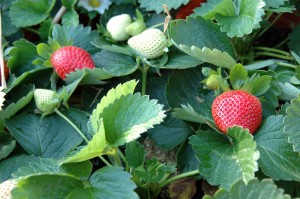May 3, 2017
Even the most strictly ornamental landscape has its share of edible plants. Crabapple and Serviceberry trees are great examples in the Ann Arbor Michigan region. Of course, sunflowers of all sizes have delicious seeds to offer. As the list below demonstrates, attractive edibles can accommodate any garden niche, and some stand out as especially striking.
*Fruiting Vegetables
*Leafy Vegetables
*Herbs
*Vines
Trees and Shrubs
This category can include everything from towering walnut and pecan trees to small blueberry shrubs. Classic additions like apples, cherries, pears, peaches, and plums can be counted on to provide a wonderful spring show. Blueberries, perfectly suited to the acidic soil of the Ann Arbor Michigan area, even, keep looking good in fall with brilliant scarlet leaves. Keep in mind that large fruit and nut trees will be dropping some of their bounty on the ground, and this limits where they can be planted.
Fruiting Vegetables
In recent years, more homeowners have been adding ornamental peppers to their garden displays. Fruit colors run the gamut from white to yellow to orange to red to purple-black. Leaves can be variegated with purple. Even the plants themselves range from several feet down to virtual ground covers. With equally variegated leaves and purple and white streaked fruit, eggplants are an alternative to look into.
Leafy Vegetables
Many vegetables can add a nice touch to the landscape, but the two big players are chard and kale. Decorative kale features smooth or extra curly center leaves in such colors as white, purple, and lavender paired with outer green leaves. With a little care, the display can continue into winter, while the leaves provide an exceptionally nutritious meal. Chard offers a vertical form of deep green or dark purple leaves highlighted with stems and veins of white, red, and yellow. Similar to chard, beets feature green leaves permeated with red veins.
Herbs
It’s impossible to name all the eye-catching plants in this category. Easily-grown perennial chives bear spherical purple blooms on their roughly foot tall stems. Silver thyme derives its name from variegated leaves of green with white edging. It’s also topped with light purple flowers. Pineapple sage is a container-grown herb sporting elongated red flowers that are also edible.
Vines
With large leaves, many varieties of grape vines supply an attractive privacy screen that becomes more appealing as the grapes ripen into purple clusters. Hardy Kiwi Vines are another perennial option with masses of white spring flowers and sometimes, variegated leaves. Unlike kiwi fruits found in stores, these are smaller, sweeter, and have edible skins. Beware that Hardy Kiwi Vines can put on 20 feet of growth a year and can be invasive.
Historically, edible plants were part of any decorative landscape. This practice lapsed only since the latter half of the 19th century. A new sense of practicality has brought it back to its rightful place, and with spring’s arrival, it might be a good time for you to bring it back to your home.
Gallery
“We recommend Twin Oaks to any entity looking for a full-service, talented, and responsive provider.”

